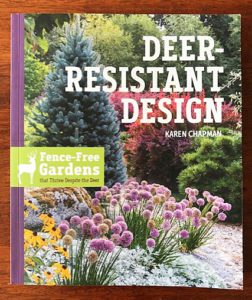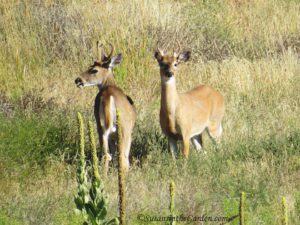Book Review: Deer-Resistant Design

Deer-Resistant Design by Karen Chapman (Timber Press, 2019, 240 pp., $24.95)
It’s widely known that the most successful method for keeping deer out of the garden is a tall fence. But fences aren’t always an option, or even desirable.
As a matter of fact, the subtitle for Karen Chapman’s newest book, Deer-Resistant Design, is definitely eye-catching. It’s certain to attract gardeners and landscape designers looking for viable alternatives: “Fence-Free Gardens that Thrive Despite the Deer.”
This book is the result of the author’s own experiences after moving to a rural property in Western Washington. Deer are definitely plentiful there. But it goes beyond that. She profiles gardens across the country that are designed to resist or withstand deer browsing and other damage. More on that in a moment.
In the introduction, Karen discusses strategies for dealing with deer such. These include as using dogs as deterrents or stringing fishing line between trees to startle them. Another idea is to exclude deer through barriers such as a rebar lattice, strategically-placed posts, and cattle grids.
She uses a rating system from Rutgers Agricultural Experiment Station showing different plants’ level of deer resistance. A: rarely damaged. B: seldom severely damaged. C: occasionally severely damaged. D: frequently severely damaged.
This link will take you to Rutgers’ searchable database of landscape plants. As Karen points out, the plants deer will browse on or damage varies from one garden to the next. Even their behavior varies in different regions.
Karen starts with a profile of her own garden, detailing the challenges she and her husband faced as well as the changes they made to overcome them. She is a master at selecting attractive plant material so I especially enjoyed reading about the plants she chose. There’s also an honest discussion about what’s working and what isn’t. The chapter ends with her top 10 plants, all of which are happen to be hardy for Inland Northwest gardens. For each of them, she provides light requirements and hardiness zones, which soon had me compiling a shopping list for additions to my own garden!
At that point, she begins her profiles of the other gardens.
“Each chapter features the story of one garden and the tenacious gardeners who tend it,” the author explains, “describing their personal design criteria, the challenges they face, and the strategies they employ as they refused to be thwarted.”
The gardens are located in New Jersey, Texas, Michigan, North Carolina, Oregon, New York and Washington state – all having very different weather, soil and other challenges, making the book applicable for gardeners everywhere. Many of the homeowners had to deal with a dizzying array of critters including voles, gophers, groundhogs, badgers, elk, rabbits, squirrels, armadillos and turkeys. Within each profile, readers will find the top 10 plants that have worked well in the garden.
Following the profiles, there is an inspiring chapter on “Deer-Resistant Container Gardens.” Since Karen is well-known for her container designs, she provides recipes for stunning containers, using plants with high deer resistance.
In the “Resources” chapter, readers will find information on each of the profiled gardens, such as the designer, landscape architect (if applicable), and any deer repellents the homeowners found useful. There is also a list of books on the topic of dealing with deer in the garden.
The book is filled with Karen’s wonderful photographs and her daughter Katie’s delightful illustrations of the layouts of both her mom’s garden and each of the profiled gardens.
What I especially like about this book is reading what gardeners in different areas of the country have done to not only address deer problems but also landscape problems that so many of us face: drainage problems, sloping land and challenging soil types. It is likely readers will find solutions for their own issues within those profiles.


